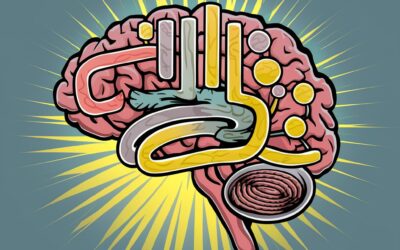mental training and visualization has been studied since the late 1800s. Mental training and visualization relies on a process called neuroplasticity, which can be broadly divided into two types: developmental plasticity, which lasts from birth to approximately age 25, and adult neuroplasticity, which exists throughout an individual's life. Adult neuroplasticity is the type of neuroplasticity on which mental training and visualization is based, as it involves actively using the brain to make changes in the brain's structure and function.
Adult plasticity, which is essentially self-directed adaptive plasticity that allows individuals to direct specific changes in terms of learning cognitive or motor function. Focused, dedicated attention to the thing that one is trying to learn is the first step in this process and is typically accompanied by agitation and frustration, which are normal and signal that things are headed towards learning. The second component required for self-directed adaptive plasticity is deep rest, particularly a good night's sleep on the night that follows the focused attention. Research shows that it is during sleep and other states of deep relaxation that the rewiring of neural connections and actual neuroplasticity take place. There are also second and third-night effects, which allow for neuroplastic events to occur during sleep on these nights following a bout of learning.
Plasticity that occur between neurons, including long-term potentiation and long-term depression. It is important to note that while the term "depression" has a negative connotation, long-term depression simply refers to a change in the connections between neurons and the excitability between neurons that can be excellent for learning things, particularly motor skills. The speaker uses the example of a child learning to eat with utensils to demonstrate the importance of long-term depression in eliminating incorrect movements to arrive at only the correct movements in a reflexive and repeated way. This process is critical for motor and cognitive skill learning and is every bit as important as long-term potentiation.
Mental training and visualization can be used to improve learning and performance. The brain's ability to sculpt down and remove connections, as well as to build up and strengthen them, is discussed as the basis of neuroplasticity. Mental training and visualization protocols, which can capture both the potentiation and depression aspects of neuroplasticity, serve as a complement to physical and cognitive training, allowing for enhanced learning speed and stability. The speaker conducts a simple experiment to show that most people are capable of visualizing a yellow cube and a red rose, and that during such visualization, the visual cortex and associated brain areas become very active, as shown in neuroimaging studies.
How perception works in the brain and how auditory and visual tasks can be imagined in the mind's eye or ear. They explain that most people are able to complete simple visualizations involving brief sequences in both senses, with a small percentage of the population having an inability to mentally visualize at all. They stress the importance of brief and simple visualizations if one wants to use mental training and visualization to engage in neuroplasticity and learning.
Processing speed and spatial relationship between imagined and real experiences. The experiments on visualization show that the neural level of mental visualization is identical to real-world events, although mental training and visualization are not as effective as the real world in terms of learning and improving performance. The ideal situation for learning is to combine real training in the physical world with mental training. The use of bistable images or impossible figures in experiments shows that mental training and visualization can be extremely effective, but it is always going to be most effective when combined with real-world training and experiences.
Real-word experiences and mental training and visualization is the most effective way to improve mental visualization abilities. While bi-stable images can be seen in real life, when someone tries to envision such images in their mind's eye, they cannot do it alone. However, tracing or drawing such an image physically and later visualizing it mentally allows individuals to switch back and forth between the faces and vases. Moreover, by mentally labeling and imagining these images, individuals can further stimulate their brains' neural machinery and fuse it with perception to achieve greater depth and flexibility in their visualization. Finally, by comparing the effectiveness of mental training and visualization to the cognitive load of recognizing faces, the speaker argues that the human brain is mainly a face recognition and expression machine.
Cognitive labels and decisions we make about the things we see in mental training and visualization is discussed. The cognitive labels assigned to mental training and visualization should be matched to real-world training and experiences, and identifying specific golf swings or aspects of it with an identity or name is crucial to the effectiveness of mental training for improving golf swings. While it is not possible to lie to oneself and learn better, mental training and visualization that accurately recapitulates real-world training is crucial for effective results. Therefore, mental training and visualization rely not only on the physical contours of things but also heavily depend on the cognitive labels and decisions we make about the things we see.
Aspects of mental visualization and how it can be applied towards mental training and visualization. He discusses experiments that show how mental training and visualization captures many of the same features of real-world behavior and perceptions, such as eye movements. The fifth principle of effective mental training and visualization is the equivalence of mental imagery versus real-world perception and behavior, which means that imagining things can be just as effective as actually doing or perceiving those things in the real world. The speaker suggests deliberately moving your eyes in the direction of the thing or things that you are trying to recapitulate in your visualization, which can greatly enhance the amount of neural machinery in the brain and body that you are able to recruit when performing real-world tasks.
Five principles of mental training and visualization established in numerous scientific research across different disciplines including education, medicine, music, psychology, and sports. The paper he refers to, "Best Practice for Motor Imagery: A Systematic Literature View on Motor Imagery Training Elements in Five Different Disciplines," establishes a number of important key takeaways including the importance of visualization being brief, simple, and repeated between 50 and 75 times per session with a rest period of about 15 seconds in between. Mental training and visualization are effective in increasing the accuracy or frequency of performing the task in the real world, but it is crucial to be able to complete the task in the real world in order for it to work.
Ratio of real-world training versus mental training for maximum effectiveness. Real-world training is found to be more effective than mental training, while mental training is still more effective than no training. However, mental training can still be helpful in situations where an individual is unable to perform the physical task, such as injury or chronic pain. Research suggests that combining real-world training with mental training can lead to even greater results in skill acquisition and retention. The speaker also notes that adding just 1 hour of mental training to 10 hours of real-world training can lead to significant improvements.
Benefits of combining mental training with physical or real-world training to improve learning and increase the speed, accuracy, and consistency of performance in cognitive and motor skills. Mental training can be added to real-world training to maximize the amount of physical training one can do. It requires focused attention when doing it in the real world or mental training, and it requires rest and sleep. The video suggests getting a good night's sleep on the day you do physical training or mental training. Studies indicate that it doesn't matter when you do mental training, but doing them both whenever you can and placing them at a time when you get good sleep is ideal. The video also stresses that sleep is vital for neuroplasticity after mental training and physical training.
Sex and age-related differences in ability to mentally visualize and train specific skills. While some initial studies identified sex differences, subsequent quality, peer-reviewed studies point to no significant differences between males and females in using mental visualization to improve cognitive or motor skills. Although age-dependent differences were found suggesting a combination of physical and mental training for individuals aged 65 or older, the vast majority of people would benefit more from physical training. The speaker also discusses first person versus third person mental visualization and the effectiveness of first-person mental training, which is significantly more effective than third-person visualization. For individuals attempting to learn cognitive skills, closing your eyes and performing the task is shown to be most effective.
Techniques for improving cognitive skills. He explains the difference between first-person and third-person perspectives and how studies have shown that watching videos of oneself from a first-person perspective can be very effective. However, if one is going to use third-person mental training and visualization, they should ideally look at themselves either on video or listen to themselves in audio and/or video. The principle of effective mental training and visualization is that whatever skill one is trying to build or consolidate needs to be brief and repeated. Huberman also presents an interesting study on how mental practice can modulate functional connectivity between the cerebellum and the primary motor cortex.
Improve on a specific motor sequence task through either intentional cue or mental practice. The study found that mental practice, consisting of 50 imagined trials, led to an increase in speed and accuracy of physical performance in the real world. The neural mechanisms behind this improvement involve the cerebellum, an area at the back of the brain that communicates with the primary motor cortex and can reduce inhibition through its outputs, allowing for more net excitation and thus more accurate and faster movements. The study also showed that the improvement in performance was not related to the activation of the motor pathways.
Go" and "no-go" aspects of motor learning and how mental training and visualization can improve both. While previous studies have primarily focused on enhancing "go" tasks like finger-tapping, there have been a few studies on the "no-go" aspect of motor learning, which is equally important in real-life tasks like golf or playing an instrument. One such task, called the stop signal task, was developed and popularized by Gordon Logan and William Cowan. Mental training and visualization have been shown to improve both aspects of motor learning, and these neural circuits are being increasingly studied to understand their underlying mechanisms.
Stop signal task is described as a reaction time test with a no-go aspect of motor execution. The task involves pressing a key corresponding to the direction of the arrow presented on the screen while inhibiting the urge to press a key when a red stop signal appears. The delay between the presentation of the arrow and the stop signal affects the ability to withhold the key-pressing behavior. In the paper, "motor imagery combined with physical training improved response inhibition in the stop signal task." It was found that physical training was superior to mental training in improving performance on the task.
Combination of mental training and physical training for improved learning. The study shows that if the thing you're trying to learn involves withholding inappropriate behavior, then combining mental training and physical training is especially important for better performance. The study involved 30 trials of the task over five days, and the improvements were significant, showing a near doubling of reduction in reaction time for the combination of mental and physical training compared to training alone. This study is important as it highlights the significance of action withholding in motor learning and training, captured nicely in the stop signal task. Also mentioned are studies that explore why certain individuals are better or worse at motor training and visualization, such as those with affantasia, a condition that impairs the generation of mental imagery.
Aphantasia, the inability to generate mental imagery, and how it varies in severity from complete absence to poor ability. He also explains that contrary to popular belief, people with aphantasia are not necessarily incapable of synesthesia, which is when people have perceptual blending that is not induced by drugs. A study found that aphantasia was associated with weak visual imagery and features associated with the autism spectrum. However, it is unclear whether aphantasia causes these features or vice versa, and not all people on the autism spectrum have aphantasia.
Mental training, visualization, cognitive and emotional perception, and behavior. He also highlights the importance of social cognition as a learned behavior and pattern of cognitive and motor patterns. Dr. Huberman emphasizes the need to incorporate physical training along with mental training and visualization when learning new skills. However, if physical training is not feasible due to injury or other reasons, mental training can be a reasonable substitute. He concludes by stating that constantly practicing mental imagery helps to improve the ability to engage in plasticity, and it is essential to create multiple parallels between real-world training and mental training.
Components that must be included in mental training and visualization protocols, such as attention, focus, sleep and deep rest, and effective mental training and visualization tools. Mental training and visualization does not have to be performed in a very precise way or done perfectly each time, but repeating it repeatedly and in a restricted way that makes it easier to perform those trials over and over and over again and with a high degree of accuracy can lead to improvements in real-world performance. The speaker encourages exploring motor training and visualization, as all studies show that some degree of improvement is observed when people use motor training and visualization on a consistent basis, even just the three to five times per week with simple repeats over and over.
Benefits of Journaling
Journ...
How to Get Over the Death of a Service Dog like a Vietnam Veteran in 78 minutes.
This...
PTSD Symptoms in Women: Understanding the Unique Challenges
Post-...
How to Cure PTSD Four Times in 5 Hours
This...
How Can Couples Maintain Intimacy While Sleeping Apart?
Sleep...
The Ultimate Guide to Walking with a Weighted Vest for Maximum Fitness Benefits
Walki...
Audiobooks Market Booming: How to Capitalize on the $53 Billion Opportunity by 2032
The...
The Audiobook Market’s Adaptation to Cultural Changes
Today...
The New Midlife Crisis: Navigating the Challenges of Middle Age
In...
Stop Overthinking and Anxiety: Practical Tips to Quiet Your Mind
How...























